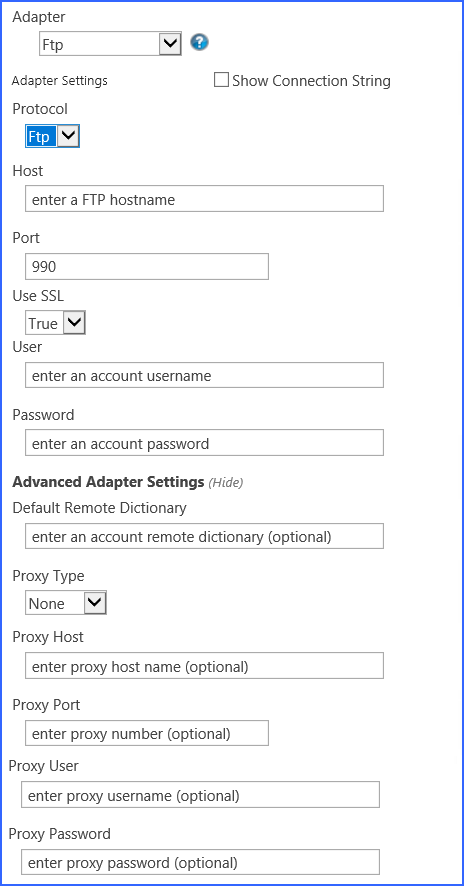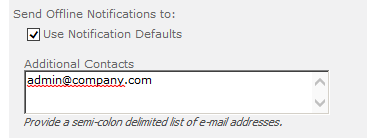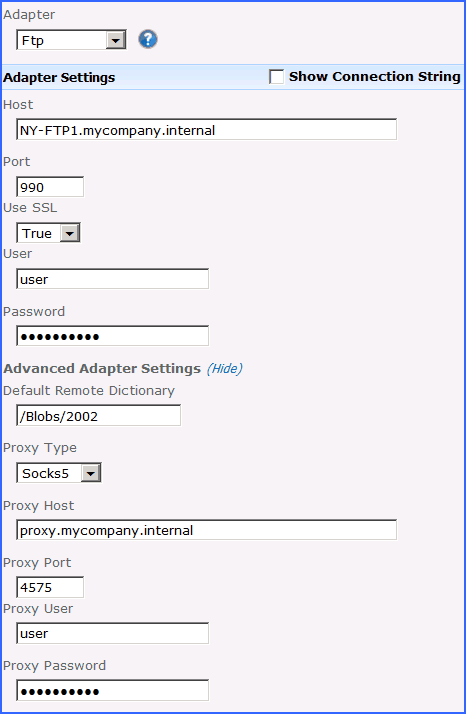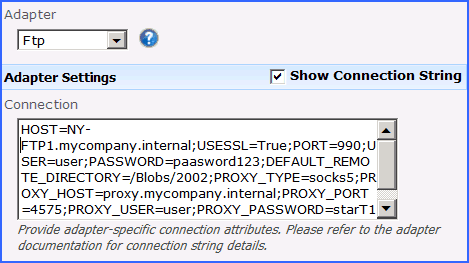FTP Adapter Confguration
The FTP adapter for StoragePoint allows you to store SharePoint content on an FTP server.
The StoragePoint team strives to keep things as simple as possible for our customers. However, before the FTP Adapter for StoragePoint will function as described in this document, additional configuration may be required.
|
|
NOTE: Do not leave connection opened (with your FTP client software) during writing to FTP type endpoint. It may cause ghost folder (duplicate folder with the same name) on FTP storage. |
This section will provide you details on how to configure a storage endpoints connection string to utilize the FTP Adapter. Please refer to the StoragePoint Reference Guide for information on managing Storage Endpoints.
On the Application Management page, click Storage and Backup Endpoints.
Click Create New Endpoint or click the name of an existing storage endpoint that you want to edit.
Click the Show link next to the Advanced Adapter Settings to see the additional fields.
FTP Adapter Connection String Parameters
|
Setting |
Value/Options |
|---|---|
|
Name |
Enter the unique name of the Storage or Backup Endpoint. |
|
Type See Backup Services Settings in the Reference Guide for more information on how Backup Endpoints are used. |
Primary this endpoint will be available for externalization when creating storage profiles. Backup this endpoint will be in the Backup Services dropdown on the profile page. The selection is locked down when saving. |
|
Status |
Online Storage Endpoint should be available to associate to a Storage Profile and accept BLOBs. (default) Offline (Read Only) A storage endpoint can be configured, but not made available for externalizing content. The BLOBs already on the endpoint are still read only. |
|
|
Select the adapter for the endpoint that is being created. |
|
|
Select Sftp or Ftp. |
|
|
FTP Host (Server) name. Must be IP address or host name. Required. |
|
|
FTP Port. The default is 21 for unencrypted communication and 990 for encrypted. It must be a number in range 1-65535. Default = 21. |
|
|
True (default) means encrypted communication (SFTP implicit FTP over STL) will be established. False means plain unencrypted FTP communication will be established. Value is set to True and cannot be edited for Sftp protocol |
|
|
FTP Account User name. Required. |
|
|
FTP Account User name password. Required. |
|
|
Default remote dictionary for FTP user account (not typically necessary to set). Not allowable for Sftp protocol. |
|
|
·None (default) ·Socks4 ·Socks4a ·Socks5 |
|
|
Proxy Host (Server) name. Must be IP address or host name. Required only if Proxy Type is None. |
|
|
Proxy Port. It must be a number in range 1-65535. Required only if Proxy Type is None. |
|
|
Proxy Account User name. Required only if Proxy Type is None. |
|
|
Proxy Account User name password. |
|
|
If the endpoint is on a WORM (Write Once, Read Many) device, Unused BLOB Cleanup will ignore this endpoint. |
|
|
No Externalized content BLOBs are not placed in folders (default). Yes Externalized content BLOBs are placed in folders. If Folder Content in BLOB Store is Yes then you can select a date/time folder scheme from the dropdown. YYYY/MM/DD/HH/MM is the default. |
|
|
The Test Storage Settings button can be used at this point, or after completing the endpoint configuration, to verify that the endpoint is accessible. |
|
|
No Externalized content BLOBs are not compressed (default). Yes Externalized content BLOBs are compressed. |
|
|
None Encryption will not be applied to externalized BLOBs (default). AES (128 bit) 128 bit AES encryption will be applied to externalized BLOBs. AES (256 bit) 256 bit AES encryption will be applied to externalized BLOBs. |
|
|
Enter a passphrase to use when generating the encryption key. Using a passphrase will help you re-create the encryption key if necessary. You can generate a random key by leaving the box blank and clicking the Generate Key button. The encryption key passphrase will be hidden. |
|
|
A warning email can be sent if the endpoint encounters errors. |
|
|
An online storage endpoint can be automatically taken offline if it encounters errors. If a storage endpoint is taken offline automatically, BLOBs that were intended to be written to that endpoint will go to the content database. |
|
|
Default email addresses for system error and offline notification can be entered. Check the box to include the list of Default Notification Contacts specified on the General Settings page. |
Example Storage Endpoint using FTP Adapter
The Show Connection String checkbox displays connection string for this adapter. Notice that the connection string parameters are name/value pairs separated by semi-colons.
|
|
NOTE: Adapter parameters are not case-sensitive. |
|
|
NOTE: You should always use a passphrase when generating encryption keys. The passphrase gives you a means of re-creating keys should they become unrecoverable or corrupt. It is very important to remember or record the passphrase outside of Metalogix StoragePoint. Otherwise, encrypted content could become irretrievable in the event of a database failure. |
If you choose to externalize content you should test the storage profile settings by clicking the Test Storage Settings button. A message under the button will indicate whether or not the test was successful. If the test fails the message will include the error that was the root cause of the failure.
|
|
NOTE: When testing access to an endpoint from within Central Administration, the Identity of the Application Pool hosting the Central Administration Site is the one that is being used for the test. If there are different Identities used for other Web Applications in the Farm then those identities will also need access but cannot be tested from within Central Admin itself. See BLOB Store Security and Metalogix StoragePoint Required Privileges in the Metalogix StoragePoint Reference Guide. |
Appendix: Troubleshooting




























